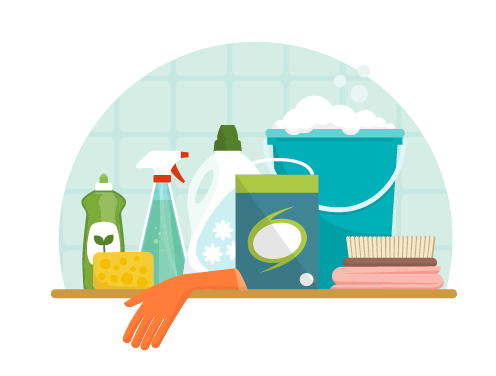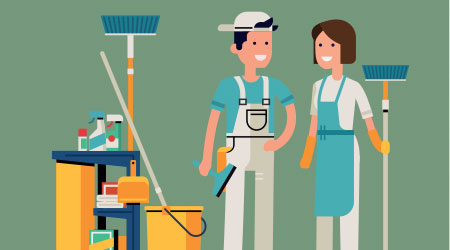Effective Everyday Cleaning Methods: Ideal Practices for Defrosted and Cleaned Every Few Months
Effective Everyday Cleaning Methods: Ideal Practices for Defrosted and Cleaned Every Few Months
Blog Article
Understanding the Requirement for Thoroughly Sanitizing and Sanitizing Often Touched Surfaces in High-Traffic Areas
In the world of public wellness and safety, the thorough sanitation and sanitization of regularly touched surfaces in high-traffic locations stand as critical actions in avoiding the spread of unsafe virus. The importance of this technique extends far past mere tidiness, diving right into the realm of illness avoidance and area well-being. By checking out the numerous elements of surface disinfection, from the dangers connected with neglecting cleaning procedures to the reliable approaches that can be employed, a clearer understanding emerges of the important function these techniques play in safeguarding public health. As we navigate this discussion, it ends up being obvious that the effects of thorough surface disinfection reverberate not only within the confines of a particular atmosphere however likewise resonate on a wider scale, affecting the health and wellness of people across diverse communal setups.
Relevance of Surface Area Disinfection
Stressing the detailed sanitation of high-traffic surfaces is crucial in keeping a hygienic environment and protecting against the spread of dangerous microorganisms. High-touch surfaces such as door manages, light switches, lift buttons, and countertops act as reproducing grounds for viruses and microorganisms. Routine sanitation of these surfaces is vital to reduce the danger of contamination and transmission of diseases.
By applying a robust sanitation protocol, establishments and companies can develop a much safer setting for workers, site visitors, and customers. Proper surface area disinfection not only alleviates the spread of infectious diseases however additionally instills self-confidence in the tidiness and safety and security of the premises. This proactive technique shows a commitment to health and health, which is specifically important in high-traffic areas where the possibility of direct exposure to virus is enhanced.
Moreover, surface disinfection plays a critical role in overall infection control techniques. Integrated with hand hygiene methods, putting on masks, and keeping physical distancing, detailed sanitation of high-touch surface areas creates a comprehensive defense against the transmission of hazardous microorganisms. Prioritizing surface disinfection is an important component of a holistic method to health and safety in shared spaces.
Threats of Neglecting Cleansing Practices
Disregarding detailed sanitation of high-traffic surface areas substantially increases the risk of viral and microbial contamination, posing a significant hazard to the wellness and security of individuals often visiting these rooms. Failure to execute proper cleaning techniques can cause the build-up and spread of hazardous pathogens, consisting of microorganisms and viruses, on regularly touched surface areas such as doorknobs, handrails, lift switches, and countertops.

Moreover, ignoring the importance of detailed cleansing not only endangers the wellness of people however also weakens efforts to keep a clean and sanitary environment. It is critical to acknowledge the significance of appropriate disinfection procedures in avoiding the spread of infections and guarding public health and wellness.
Reliable Disinfection Approaches
To maintain ideal cleanliness and minimize the risk of contamination on high-traffic surfaces, using effective sanitation methods is vital. Among the most typical and efficient sanitation techniques is making use of chemical anti-bacterials. These products can vary in stamina and make-up, with some targeting particular virus like viruses or bacteria. It is crucial to comply with the supplier's instructions for appropriate dilution, get in touch with time, and air flow when using chemical disinfectants to ensure their efficiency - defrosted and cleaned every few months.
An additional reliable approach is making use of UV-C light. UV-C light has actually been revealed to be reliable in eliminating a vast selection of microbes by interrupting their DNA framework, hence stopping them from reproducing. Nonetheless, it is important to make use of UV-C light effectively, ensuring that the correct intensity and direct exposure time are related to attain the preferred sanitation outcomes.
Additionally, using heavy steam cleaning as a disinfection approach can be highly reliable, particularly on surfaces that are heat-resistant. Vapor can penetrate permeable surfaces and kill germs, viruses, and various other pathogens properly. When using vapor cleaning, it is necessary to make sure that the surface area reaches the wikipedia reference required temperature for an adequate amount of time to guarantee appropriate disinfection.
Effect on Public Wellness
The upkeep of high standards of tidiness and disinfection on high-traffic surface areas plays a critical function in safeguarding public health and wellness. Frequently touched surface areas in areas with high tramp, such as doorknobs, handrails, elevator switches, and restroom facilities, offer as breeding grounds for unsafe pathogens. Stopping working to properly sanitize these surface areas can bring about the rapid spread of contagious conditions within communities. By executing detailed disinfection protocols, the danger of transmission of infections, microorganisms, and various other germs can be considerably minimized.
In high-traffic areas like airports, colleges, healthcare facilities, and public transportation systems, the impact of strenuous disinfection measures can not be underrated. Prioritizing the sanitization of regularly touched surface areas is a proactive strategy to promoting public wellness and improving the safety of people in shared rooms.
Executing Regular Cleaning Up Protocols
Immediately instituting and sticking to a consistent timetable of cleansing protocols is extremely important for preserving the sanitation and security of high-traffic surface areas. Regular cleansing protocols are necessary in avoiding the build-up of germs and microorganisms on regularly touched surfaces, specifically in areas with high foot web traffic. By applying a methodical technique to cleaning, organizations can successfully reduce the danger of condition transmission and create a healthier setting for staff members, customers, and the general public.
To develop an effective cleaning routine, it is crucial to determine high-traffic areas that need constant focus. These areas may include doorknobs, hand rails, lift switches, bathroom facilities, and shared devices. Applying a regular cleansing regimen that targets these surfaces several times a day can substantially lower the spread of harmful bacteria and viruses.
Additionally, using ideal cleansing representatives and disinfectants is key to guaranteeing that surfaces are completely sterilized. Routine training of cleaning up personnel on appropriate cleaning methods and the significance of adherence to the cleaning routine is also important in preserving a hygienic environment. By prioritizing regular cleansing methods, companies can promote the health and wellness and well-being of individuals that connect with these high-traffic surface areas.

Final Thought
In verdict, it is vital to focus on complete disinfection and sanitization of often touched surfaces in high-traffic areas to protect against the spread of harmful pathogens and keep public wellness. It is necessary to acknowledge the importance of maintaining tidy surfaces in high-traffic locations to make sure the wellness of the area.
In the world of public health and official site safety and security, the careful disinfection and sanitization of regularly touched surface areas in high-traffic areas stand as extremely important steps in preventing the spread of unsafe microorganisms. By exploring the numerous facets of surface area disinfection, from the threats associated with disregarding cleaning methods to the efficient approaches that can be utilized, a more clear understanding emerges of the crucial role these methods play in safeguarding public health and wellness.Additionally, utilizing vapor cleaning as a sanitation method can be extremely effective, particularly on surface areas that are heat-resistant. When using heavy steam cleansing, it is important to make sure that the surface area reaches the needed temperature level for a sufficient quantity of time to assure proper disinfection.
In verdict, it is crucial to prioritize detailed disinfection and sanitization of often touched surface areas in high-traffic locations to prevent the spread weblink of damaging virus and keep public health.
Report this page